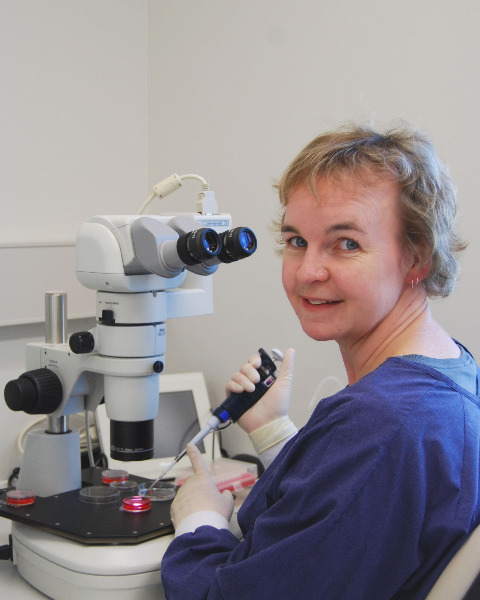Ovary/Oocyte
Poster Session C
(P-305) Oocyte Storage Vesicle and Lipid Droplet Composition and their Role in Oocyte Quality
Friday, July 19, 2024
8:00 AM - 9:45 AM IST
Room: The Forum

Karen L. Reader, PhD (she/her/hers)
Senior Lecturer
University of Otago
Dunedin, Otago, New Zealand
Poster Presenter(s)
Abstract Authors: Karen L. Reader; Georgia L.G. Lawson
Department of Pathology, University of Otago, Dunedin, New Zealand
Abstract Text: Poor oocyte (egg) quality is a leading cause of reduced fertility in humans and animals, but we do not yet understand how to improve oocyte quality nor how to identify good quality oocytes. Oocyte vesicles, also referred to as vacuoles, have been described using transmission electron microscopy (TEM) in many different species and can constitute up to 30% of the cytoplasm. Despite this, the composition and function of these organelles has been largely ignored in the literature. Using a sheep model of oocyte quality, we have shown that the volume of vesicles is lower in poorer quality lamb oocytes when compared to higher quality adult ewe oocytes, and vesicle volume decreases during maturation, suggesting these organelles are important determinants of oocyte competence. The initial aim of our study was to identify the composition of these oocyte vesicles. Using centrifugation to segregate the different oocyte organelles, and live cell confocal microscopy with Nile red staining and different excitation wavelengths, we have shown that vesicles contain lipid that is of a different form to the lipid droplets conserved by conventional EM fixation methods. We then carried out a lipidomic study using mass spectrometry to compare oocytes from lambs (poor quality) and adult ewes to identify lipids that are lacking in the poorer quality oocytes. Data was analyzed in MS-DIAL using the LipidBlast reference library to identify peaks. The area under the peak was normalized and mean abundance of each metabolite in three pools of 20 oocytes each from adults and lambs was analyzed by t-test. The most abundant lipids in both ages were a mixture of saturated and unsaturated fatty acids. A total of 28 metabolites were significantly increased and 68 were decreased (P < 0.05) in lamb compared to adult oocytes and the ontology of 60 of these was identified from the reference library. Diacylglycerides and ceramides were the most common subclass to have reduced abundance in lamb oocytes. Interestingly, progestogen was the sixth most abundant lipid in adult oocytes and was significantly reduced in lamb oocytes. In conclusion, oocyte vesicles contain lipids likely to be saturated lipids not preserved by conventional osmium tetroxide fixation and poorer quality lamb oocytes are deficient in several key lipids. Future work will examine the effect of supplementation of lamb oocytes with progestogen, diacylglycerides and ceramides during in vitro maturation and fertilization to determine if oocyte quality (blastocyst rate) can be improved.
Department of Pathology, University of Otago, Dunedin, New Zealand
Abstract Text: Poor oocyte (egg) quality is a leading cause of reduced fertility in humans and animals, but we do not yet understand how to improve oocyte quality nor how to identify good quality oocytes. Oocyte vesicles, also referred to as vacuoles, have been described using transmission electron microscopy (TEM) in many different species and can constitute up to 30% of the cytoplasm. Despite this, the composition and function of these organelles has been largely ignored in the literature. Using a sheep model of oocyte quality, we have shown that the volume of vesicles is lower in poorer quality lamb oocytes when compared to higher quality adult ewe oocytes, and vesicle volume decreases during maturation, suggesting these organelles are important determinants of oocyte competence. The initial aim of our study was to identify the composition of these oocyte vesicles. Using centrifugation to segregate the different oocyte organelles, and live cell confocal microscopy with Nile red staining and different excitation wavelengths, we have shown that vesicles contain lipid that is of a different form to the lipid droplets conserved by conventional EM fixation methods. We then carried out a lipidomic study using mass spectrometry to compare oocytes from lambs (poor quality) and adult ewes to identify lipids that are lacking in the poorer quality oocytes. Data was analyzed in MS-DIAL using the LipidBlast reference library to identify peaks. The area under the peak was normalized and mean abundance of each metabolite in three pools of 20 oocytes each from adults and lambs was analyzed by t-test. The most abundant lipids in both ages were a mixture of saturated and unsaturated fatty acids. A total of 28 metabolites were significantly increased and 68 were decreased (P < 0.05) in lamb compared to adult oocytes and the ontology of 60 of these was identified from the reference library. Diacylglycerides and ceramides were the most common subclass to have reduced abundance in lamb oocytes. Interestingly, progestogen was the sixth most abundant lipid in adult oocytes and was significantly reduced in lamb oocytes. In conclusion, oocyte vesicles contain lipids likely to be saturated lipids not preserved by conventional osmium tetroxide fixation and poorer quality lamb oocytes are deficient in several key lipids. Future work will examine the effect of supplementation of lamb oocytes with progestogen, diacylglycerides and ceramides during in vitro maturation and fertilization to determine if oocyte quality (blastocyst rate) can be improved.
